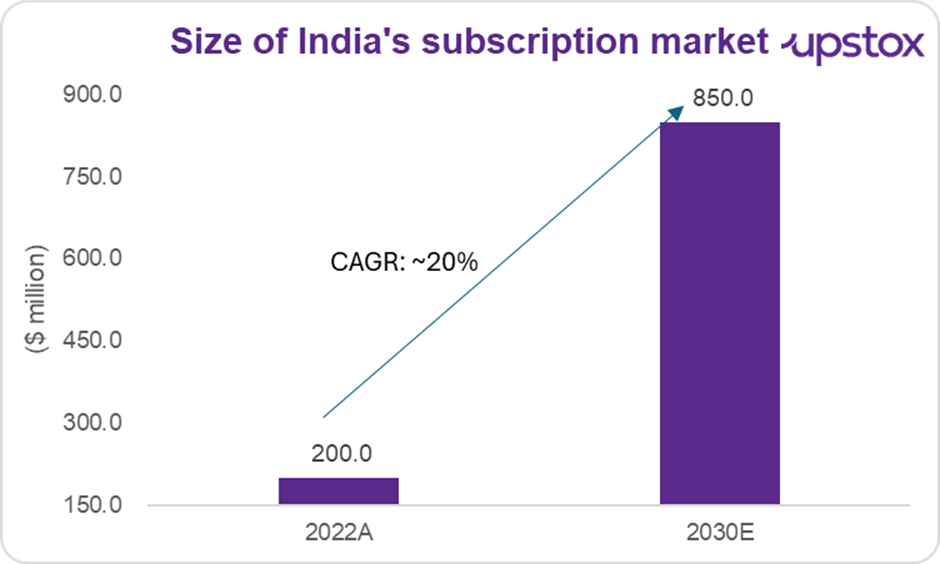Upstox Originals
Turning subscriptions into relationships: Boxed, bundled and personalised
.png)
5 min read | Updated on February 19, 2025, 16:38 IST
SUMMARY
Subscriptions are not new! From print newspapers to magazines, they’ve been part of daily lives. Now, they’re bigger than ever—ranging from content and meal kits to fitness plans. Providers are tailoring services even further, bundling offerings to maximise value. In this article, we dive into the latest trends shaping the subscription economy.

One of the key growth drivers of the subscriptions business model is the predictable, recurring revenue it offers businesses
The allure for businesses: Predictable revenue and long-term engagement
Subscriptions aren’t just a passing trend – they’ve become a vital business model, fueled by the growing demand for personalised and on-demand services.

Source: Grandviewresearch; A = actual; E = expectation
One of the key drivers of this rapid growth is the predictable, recurring revenue it offers businesses.
Take Netflix, for example. With over 230 million subscribers by Q4 2024, Netflix’s revenue reached $39 billion, growing 16% year-over-year, despite fierce competition. Spotify, with 260 million paying users, has similarly benefited from its customised playlists and curated content.
Subscriptions not only help businesses scale but also create loyalty and deepen customer engagement—key elements for long-term growth.
Building relationships: From transactions to engagement
One of the most compelling aspects of subscriptions is how they turn transactional interactions into ongoing relationships. Successful companies don’t just offer a product or service; they provide experiences that keep customers coming back for more.
Peloton is a great example. Instead of just selling access to fitness classes, Peloton has fostered an online community where users interact and share their progress. With over 2.5 million subscribers, the company benefits from high retention rates because users feel connected not just to the service but to the community itself.
Apple’s subscription offering, Apple One, bundles services like Apple Music, Apple TV+, and iCloud storage, creating an integrated ecosystem that locks customers into multiple touchpoints with the brand. With over 1 billion active devices globally, Apple taps into its vast user base to cross-sell services, ensuring users stick with its ecosystem for years to come.
Smarter subscriptions: Leveraging AI and personalisation
Today’s subscription models are becoming smarter, thanks to AI and data analytics. Businesses are using these technologies to provide more personalised and engaging experiences for their customers.
Spotify, for example, uses AI to create personalised playlists, such as its “Discover Weekly” feature, based on users’ listening habits. This keeps users engaged and gives them the sense that the platform is uniquely tailored to their preferences.
Similarly, Amazon Prime isn't just about free shipping anymore. It also uses its vast data ecosystem to recommend products, movies, and even exclusive deals, giving customers a seamless and tailored experience. In Q4 2023, Amazon Prime reached over 200 million subscribers, making it a cornerstone of Amazon's business.
These unique experiences increase customer loyalty by making subscribers feel like they are getting more value for their money. AI helps businesses refine their services and tailor them in ways that were impossible just a few years ago.
Vertical SaaS: The next big thing in subscription
Think of it this way: Traditional SaaS tools provide generalised features that almost any business can use, but with vertical SaaS, companies get software built specifically for their industry’s demands. For example, Procore provides project management software built just for the construction industry, with tools to help manage schedules, budgets, and projects.
Similarly, Veeva Systems offers software designed for the life sciences sector, helping pharmaceutical companies manage regulatory compliance and clinical trials. Veeva reported $2.15 billion in revenue, demonstrating the increasing demand for specialised solutions (Q4 2023).
This industry-focused approach makes vertical SaaS a perfect fit for the growing trend of subscription-based models. Businesses no longer have to pay for broad, generic tools that may require customisation and additional work to meet their needs. Instead, they can subscribe to solutions that are already tailored to their industry, increasing efficiency, reducing complexity, and providing more value.
With subscription-based pricing, businesses can scale up or down based on their needs, which makes these tools even more appealing.
Raising prices for sustainability: The role of AI and inflation
As businesses face rising operational costs, particularly in technology development and content creation, many subscription-based platforms are increasing their prices. But how do they justify these hikes?
AI plays a critical role in this equation. Companies like Salesforce have integrated AI-driven tools, such as predictive analytics and automated workflows, into their platforms. These added features improve customer outcomes, helping businesses make better decisions and work more efficiently.
For instance, in 2023, Salesforce raised its prices but also added more value to its offerings with AI-powered tools. This helped Salesforce maintain profitability even in the face of inflation. The company’s stock price increased by 30% that year, showing that value-added services, powered by AI, can justify higher subscription fees.
The challenges: Churn, saturation, and CAC
Despite its many advantages, the subscription model faces challenges, primarily customer churn. Companies like Netflix and Spotify tackle this by offering exclusive content and expanding services, such as Netflix’s move into gaming and localised content to appeal to global audiences.
Pricing is another hurdle; companies must balance competitive rates with profitability. For instance, Netflix’s mobile-only plan in India attracted subscribers but didn’t deliver the expected revenue, showing the need for market-specific pricing.
Additionally, high customer acquisition costs (CAC) in saturated markets, like Amazon Prime, mean businesses must keep innovating to maintain growth and justify marketing expenditures.
Final thoughts
The subscription model has reshaped how businesses operate, offering predictable revenue, long-term customer engagement, and personalisation. However, the growing competition means companies must address challenges like churn, pricing, and customer acquisition to succeed.
Looking ahead, those businesses that continue to innovate, using data, AI, and vertical SaaS to enhance value for their subscribers, will lead the charge in the subscription-first world. By focusing on bespoke, value-driven experiences, subscription-based businesses will continue to thrive.
About The Author
Next Story
